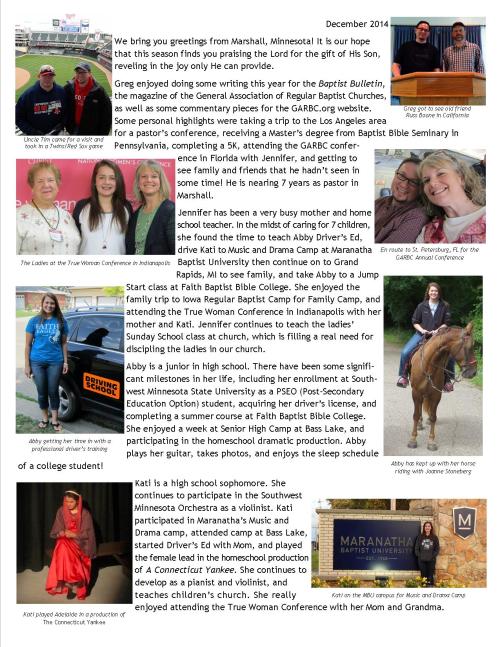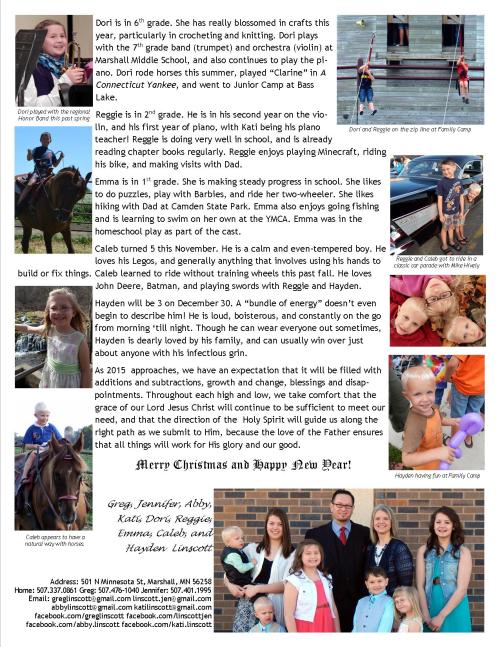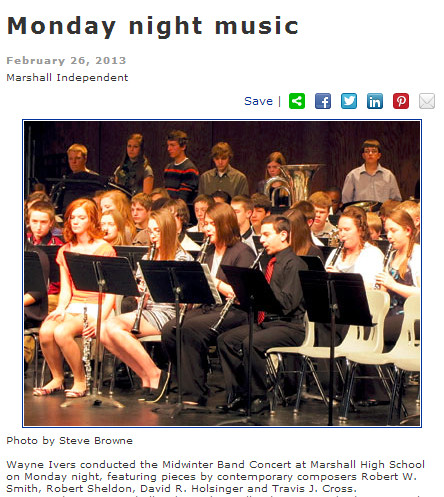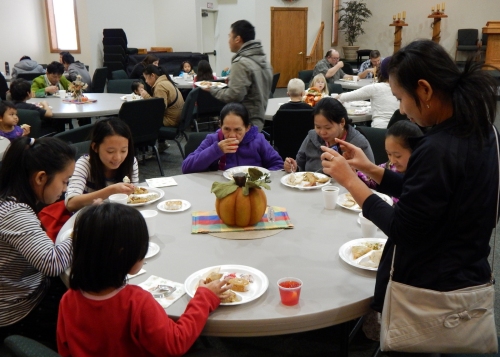Greg Linscott
1 November 2014
Speak- Taken from Acts 18:9-10
This is something I drew on in preparing to preach, taken from Acts 18:9-10.
Fear not, for I am with you,
I am your shield and guide.
My arms will hold, support you—
I’m always close beside.
No threat will e’er distress you
Apart from my consent.
I’ll faithfully direct you;
So rest, and be content.
So speak—do not keep silent;
Proclaim the news abroad.
Declare the one called Jesus
Has paved the way to God.
The Savior’s won the pardon,
The penalty’s been paid.
Extend the invitation:
Believe—and you are saved.
The people’s hearts are ready
The gospel to receive.
Soon many in this city
Will hear—repent—believe!
Be faithful; always ready
To share my Word with men.
Call each one to repentance—
Repeat the news again!
31 October 2014
Why Fellowship With Other Churches?
I enjoy interacting with other pastors and do so as often as I can, considering the church where I serve is in a comparatively rural community. Sometimes that interaction is face-to-face, and sometimes it takes place electronically. One topic that is frequently raised in casual conversations is whether or not church associations still have value today. Sometimes concerns are practical: “I can’t spare the time,” or “The distance is too imposing.” Some objections are more principled: “My priority is the local church,” or “You don’t see associations in the Bible.” Others are generally indifferent: “Our church is doing fine on its own,” or “Who needs more potential headaches?” If you’re one of those kinds of people, or you know a pastor who is, I would like to offer three reasons why you should rethink your approach and make a church association a higher priority than it might currently be for you.
1. Friendships are important. I will concede that you will have a hard time finding a formal church association structure described or prescribed in the New Testament. You don’t see things like church membership rolls and church clerks either—but we see such things warranted by the need to identify and define a local assembly. A pastor is going to one day give an account for those he shepherds (Hebrews 13:17), so these things aid in identifying those he is responsible for.
In a similar way, while we may not see organized associations prescribed in the New Testament, we do see a general expectation to maintain a spirit of fraternity and brotherhood in passages such as Hebrews 13:1, 1 Peter 2:17, and 1 Thessalonians 4:9. Hebrews 10:24 says believers are to provoke one another to love and good works. The Pauline epistles offer evidence that congregations regularly interacted with one another. The epistle to the Colossians was to be shared with the church in Laodicea. Galatians was written to a group of churches. The Corinthians are commended for their generosity in giving to help another congregation. Personal greetings from specific parties in one church to those in another are frequent throughout. The model provided by the early church in Scripture certainly seems to indicate at the very least a fraternal bond between congregations.
We know that personal friendships are seen as valuable throughout both the Old and New Testaments. The best ones are those that stay with you through adversity. When established in a church association, we must not forget that the formal structures are but mechanisms to encourage relationships that can be drawn on in difficult times. Waiting until your church actually encounters difficulty to find others to stand with and lean on is at best negligent, and at worst selfish and conceited. If your church is strong and prospering, investing it in the life of an association should be seen as an opportunity to aid those struggling, for the strong to bear the infirmities of the weak.
2. The benefit of perspective. Proverbs establishes multiple times the value of wise counsel and counselors (11:14; 12:15; 15:22; 19:20; et al.). Churches should be mindful of the benefit of experience and expertise when they can minister to and serve each other in this way. Whether it is a young pastor gaining encouragement from a man with more experience, a congregation receiving guidance as it looks for new leadership, or even businesspeople in one congregation sharing the benefit of their perspective with a sister congregation that is traveling new ground, maintaining an active presence in an association is to a large degree about maintaining a pool of counselors.
3. Shared resources = greater success in responsibilities. In a time when many churches are experiencing decline, pooling resources to better accomplish together what we could not do alone becomes an even greater priority in establishing and perpetuating local churches. The collaboration of like-minded congregations has enabled missionary efforts from this country for well over a century. Ministries like camps, publishing, and education become more efficient and achievable when congregations work together. Many churches may never have the capability to develop and finance a pastor or missionary in another location, but they can find ways to contribute in that process with other congregations. The process of making disciples is a defining responsibility of any true church of Jesus Christ, but the capabilities and relative strengths of each church will vary greatly from one congregation to the next. The efforts of a collaborative association should never take the place of an individual congregation’s sense of obligation to obey. However, a church that identifies and utilizes compatible partners will generally increase its efficiency and productivity.
How Can I Encourage Greater Fellowship Between Churches?
- Start a pastors’ reading group. I am currently participating in a group that meets about once a quarter. We rotate the book selection responsibilities among the participants and meet for breakfast, discussion, and prayer.
- Familiarize your congregation with area pastors. Consider using other pastors to speak at events like youth events, men’s fellowships, banquets, or similar occasions. Occasionally invite other pastors to fill your pulpit during a regular service, and be available to do the same in other churches too.
- Pray publicly for sister congregations. This can be for specific needs as they arise or more regularly in a rotation—for churches in your state or regional association, for example.
- Keep communication open. With electronic communication, this is very easy to do. Solicit input from others when you need advice, even on everyday things like which commentary to purchase or a good place to buy a car. When scheduling missionaries on deputation or furlough, consider working with neighboring congregations for ease in travel.
- Travel together. I have found that some of the best conversations and friendships forged with other pastors have taken place while carpooling to a conference or board meeting. Take the opportunity to reach out; stretch across age differences too.
- Look beyond your traditional boundaries. There are like-minded churches with whom we may not be formally affiliated. Whether or not they ever take the step of organized fellowship, reaching out and building bridges can create opportunities for possible collaboration and networking that would not be realized otherwise. Take the initiative and start something!
Note: Originally published at garbc.org
26 October 2014
Delight Yourself in God Alone- Inspired by Acts 17
This is something I drew on in preparing to preach from Acts 17:22-34.
Delight yourself in God alone
The Lord of earth and Heav’n.
Composer of all nature’s song
The score by Him was penned.
The notes resound among the stars
And thunder o’er the plain.
The Christ Who made them is their King
And sovereign is His reign.
Delight yourself in God alone
Who every need supplies.
He gives his creatures life and breath
And knowledge to the wise.
He has no need, no want, no lack
That someone else provides
His presence transcends space and time
In Him all pow’r abides.
Delight yourself in God alone
Whose likeness each man bears
His image is an attribute
That every person shares.
He made mankind to seek His face
To know Him and be known
Desiring as we grope for Him
That we become His own.
Delight yourself in God alone
And worship at His feet
He will not be confined within
Some grand, elaborate suite
Instead, within our hearts and selves
Our Lord desires to live
He calls us to repentance, and
Stands ready to forgive.
Delight yourself in God alone
This righteous Judge of all.
He promises eternal life
To those His Son will call.
His death atoned for all our sin
His life our hope secures.
This Christ, your only guarantee
In Him, you will endure.
21 October 2014
Everyone Looks
There is a story making the rounds at the moment about several celebrities whose privacy was compromised by computer hackers. Revealing photos were illegally acquired and made available publicly. While decrying the theft of these images, one popular actress justified why she had photographed herself by explaining that either her boyfriend would look at pornography, or he would look at her. This statement sadly reflects a conclusion that many in our society have reached: young men viewing pornography is both inevitable and acceptable.
Sooner than I care to admit, my own daughters will be nearing the age when they will think of men and marriage. As both their pastor and their father, I want them to know they cannot ever hope to gratify the appetites of any man who tries to satisfy himself by viewing pornography. When a man looks in that direction, he is looking to selfishly satisfy his own appetite. Such gratification takes place in a shameful, secretive manner that will trap him in an endlessly repetitive cycle. The hunger he seeks to feed will not and cannot ever be appeased. This is why we are instructed in 1 Peter 2:11 to “abstain from fleshly lusts which war against the soul.” The damage of such behavior can extend to the very core of a person.
That isn’t to say that anyone who has ever struggled with pornography must be considered permanently disqualified from any future consideration. I want my girls to find someone with character—whose honesty they can trust; someone who is not given to unrestrained anger. I don’t expect them to find someone who has never told a lie or who has never lost his temper. In the same way, I also want each of them to find a man who has learned to discipline himself and keep his body under subjection (1 Corinthians 9:27). Current statistics seem to suggest that their prospective husbands will have had some kind of exposure to pornography. However, a faithful husband will be the kind of man who has learned that he must delight in and “live joyfully with the wife” he loves (Ecclesiastes 9:9).
When confronted with the stark reality of society’s corrupted morals, some might conclude that the best way a Christian woman can respond is to be as plain and unattractive as she can be! However, in 1 Timothy 2:9 Paul establishes godly expectations for attire. Clothing choices need to be made in a way that shows respect for self and others—modestly, as opposed to inviting attention. At the same time, he does say a woman is toadorn herself. A sense of beauty, style, and grace can and should enter into the process of clothing choice.
Just as a young man has appetites that cannot be satisfied by pornography, our daughters need to be careful to recognize their own appetites. A young woman’s legitimate desire for love and acceptance cannot be fulfilled with the attention that exposure and dressing provocatively can bring. The damage done to one’s soul is as real for the woman seeking illicit attention as it is for the young man seeking improper gratification. The response to each desire is clear: flee!
While a godly woman should choose her clothing in a way that accents her beauty, Paul makes clear that a Christian woman will make her mark by her behavior. First Timothy 2:10 says that the proper way the godly woman will be noticed is by “good works.” The demonstration of character—things like honesty, integrity, kindness, being quick to forgive and slow to take offense—will establish attractiveness and appeal in a far more enduring way than a few provocative images will ever accomplish. The satisfaction derived from a life lived for God’s glory is something that cannot be duplicated.
Parents, don’t let your daughters be deceived into thinking they can win a boy’s affections by appealing to his appetites. Help them resist the lie that exposing their bodies to anyone but their husbands will in any way secure lasting love. Teach them of genuine beauty, and putting that beauty on display through Christ-like conduct. Everyone looks . . . so let’s make sure we’re helping people see the right things!
Note: Originally published at garbc.org
23 September 2014
A Thoughtful Conversation Between Baptist Brothers
For Baptist fundamentalists, “dual affiliation” has been a phrase charged with historical tension. In times gone by, the term was significant in the events that led to the birth of the General Association of Regular Baptist Churches, as well as the stream from which the Minnesota Baptist Association and the Fundamental Baptist Fellowship International emerged. The way that separation is perceived in those organizations has changed dramatically in the decades since those differences were prominent. Nevertheless, these various associations and fellowships have rarely intersected with one another in any formal manner. While occasional cross-pollination has occurred, a sense of suspicion has lingered with many on both sides of the aisle.
Recently the matter of dual-affiliation was raised in a new context. I pastor First Baptist Church in Marshall, Minn. We have a ministry to Karen refugees from southern and southeastern Myanmar (Burma). We wished to counter the tendency these transplanted believers would have to gravitate to their roots and relationships with the American Baptist Churches USA. This led me to question whether it would be permissible for a congregation to enter into fellowship in Regular Baptist associations while retaining that church’s established fellowship in the Minnesota Baptist Association.
The question of such “dual affiliation” was not a matter the leaders of these associations had previously pondered. Each of them deliberating the matter could not find any reason to prevent such an attempt. So this past summer, First Baptist of Marshall was received into the fellowship of the GARBC, and this fall, into the Minnesota Association as well.
Panel Discussion
Prompted to a great degree by our actions as a church, on a sunny Friday in September, over 100 Baptists from Minnesota, Iowa, and Wisconsin gathered in the fellowship hall of Fourth Baptist Church, Plymouth, Minn., for a panel discussion over lunch. The event was billed as “The Future of Baptist Fundamentalism: A Thoughtful Conversation between Baptist Brothers.” Panelists included GARBC National Representative John Greening, Central Seminary Research Professor and Regular Baptist Press author Kevin Bauder, and USAF Chaplain Col. Mike Sproul, who is also pastor of Tri-City Baptist Church in Chandler, Ariz., and on the executive board of the Fundamental Baptist Fellowship International. They were joined by host pastor Matt Morrell of Fourth Baptist Church; hymnwriter and author Chris Anderson, pastor of Killian Hill Baptist Church in Lilburn, Ga.; and me. Brent Belford, an administrator at Central Seminary and member of the pastoral staff at Fourth, moderated the discussion.
The meeting felt significant, and not just because of the subjects being deliberated. Rarely had such a diverse group of Baptist fundamentalists been assembled in such a context. Several faculty members from Faith Baptist Bible College and Theological Seminary sat alongside their counterparts from Central Baptist Theological Seminary. Numerous Minnesota Baptist Association pastors were present, sharing tables with people such as Tim Capon of the Iowa Association of Regular Baptist Churches, Darrell Friar of the Minnesota Association of Regular Baptist Churches, Wayne Vawter of the Wisconsin Fellowship of Baptist Churches, and Garry Thompson of the New Testament Association of Independent Baptist Churches. Each of these leaders was accompanied by pastors from representative congregations of their constituencies. Given past history, one might expect uncomfortable silence, but, instead, there was a sense of energy and anticipation in the room.
Kevin Bauder
In his opening remarks, Kevin Bauder described the current state of fundamentalism. He spoke of historically discernable categories within fundamentalism, distinguishing between the nondenominational, Presbyterian, and Baptist categories, while also identifying a recently discernable “hyper-fundamentalist” category primarily identified by its insistence on the exclusivity of the King James Version. He further identified the Northern and Southern streams observable within the Baptist category.
John Greening
At Brent Belford’s direction, John Greening assessed the current state of the GARBC. He acknowledged that the number of fellowshipping churches has somewhat dwindled in recent days, not because churches were “jumping ship,” so much as from older churches losing vitality and closing their doors. Greening lamented that historical anecdotes, such as those included in Kevin Bauder and Robert Delnay’s One in Hope and Doctrine(Regular Baptist Press), have revealed instances in which core principles have become sidetracked at the expense of organizational issues. Greening confessed he found these times “embarrassing” and “not a good thing.” However, he used this observation to deliver a powerful reminder of behaviors fundamentalists often seem to espouse:Fundamentalism all too often, in a misapplication of separation, sometimes is like [the man in the parable that buries the talent]. We feel really good about giving God back exactly what He gave us. . . . We protected it. . . . But we may reach the day when we stand before the authority figure and He says, “Tell me what you did with the investment,” and we reply that “I thought You wanted me to protect it all the time.” Obviously, we need to guard truth, . . . but we also have to champion it! We have to leverage the collective brain trust, our commitment to the ideas of fundamentalism, and turn them into something in the context of religious debates. So, we’re speaking to issues, we’re making points, we’re writing books, we’re putting up posts and blogs.
Mike Sproul
Belford then asked Mike Sproul to speak to the current state of the FBFI. Sproul recounted his earliest memories as the son of an itinerant evangelist and member at Tri-City Baptist (the congregation he now serves as pastor) under his predecessor, Dr. James Singleton. Singleton’s ministry career included personal departures from the Southern Baptist Convention, GARBC, and Baptist Bible Fellowship International, leading Sproul to sum up the heritage of his congregation as being “come out, come out, wherever you are!” Comparing the organizational differences between an association like the GARBC and a pastors’ fellowship like the FBFI, Sproul explained that the platforms of FBFI meetings were not the collective voice of the organization. Rather, each speaker was responsible for his own words. While like an association, a fellowship will generally gather around its core beliefs expressed in its constitution and resolutions, sometimes the political preferences can center around whether an individual favors a particular personality style or not. Sproul acknowledged the “warts” in his corner of fundamentalism in a bit of a jocular fashion: “We get to critique people and not be responsible for anyone else within our own orbit!” In the same breath, he observed that young men can sometimes cast a cynical look at the context they were raised in because they see what is “behind the curtain,” while only seeing the greener grass on the other side of the fence when looking at the conservative evangelicals. Recent revelations of problems in those camps, such as situations involving Mark Driscoll and C. J. Mahaney, have served to remind fundamentalists that warts exist outside of fundamentalism too.
Chris Anderson
Chris Anderson spoke as a currently unaffiliated pastor. Growing up in the home of an IFCA International pastor, Anderson attended and graduated from Bob Jones University. Initially in his ministry career, Anderson envisioned separation “alphabetically,” with organizations such as the Ohio Bible Fellowship or the FBFI representative of the ideal. Groups such as the GARBC and IFCA he saw as “compromised,” while anyone associated with the SBC was obviously “beyond the pale.” While serving as a church planter in Ohio, Anderson started blogging and interacting with a wider sphere of people, including people like me, whom he had met through the SharperIron blog/forum. Eventually, Anderson began to develop a more nuanced view of partnerships based on Biblical fidelity. In his current ministry as a pastor in Georgia, Anderson confessed that he is beginning to see the downside of independence and the lack of leverage that a church can have when it has no influence in a national organization.
Discussion of Music
As the audience considered these viewpoints, Belford directed the attention of the panel to an often controversial topic within Baptist fundamentalism: music. Greening observed that a diversity of worship styles is tolerated in the GARBC—a tolerance that can become a tension when the congregations united by common doctrinal position convene in meetings. The culture of the GARBC, Greening explained, allows a range of tolerance to exist for a range of styles among independent churches. As the congregations function together, they have learned not to “push the edge of the envelope,” choosing selections that will be acceptable to the group as a whole. While it can be like walking a fine line, he acknowledged, Greening concluded that substantive music, true and consistent with Scripture, is a collective priority of the association.
The churches represented in the FBFI have a limited range of music styles they would employ, Sproul explained. A commonality among these congregations is that their worship is hymnal based. In clarifying the range of diversity within his fellowship, Sproul gave an example of a resolution that was presented to the FBFI board to avoid the use of music such as produced by Sovereign Grace Ministries or Keith and Kristyn Getty—a resolution that did not ultimately receive the support of the board. While the rejection of the performance style employed by these artists would be a point of unity within the fellowship, many see the benefit of incorporating a few of these songs accompanied by a more traditional instrumentation.
As he shared his personal views on music, Bauder prefaced his remarks by observing that the spectrum of music in the two associations in Minnesota was virtually identical. Music, apart from lyrics, is a language capable of conveying meaning, Bauder concluded. He further would say that a church’s position and practice in this area can be just as important as their position on the Virgin Birth. At the same time, Bauder noted, not every departure from strict truth constitutes an apostasy. Even with the definite convictions he holds personally, there must be allowance for different conclusions, or even perceived “disobedience” in a limited sense.
Anderson, whose ministry includes writing hymns through churchworksmedia.com, added his opinion on the music debate: “Fundamentalists have placed too much weight on the music issue.” Anderson spoke of a pastors’ conference he had attended where the speaker grossly mishandled the Scriptures, doing so to such an extent that Anderson felt compelled to leave. Later, in conversing with the host pastor, Anderson expressed his concerns. The host pastor conceded Anderson’s point, but ultimately defended the speaker by saying that “he took a good stand” in regards to music and separation. Anderson observed:
For some fundamentalists . . . we allow people to deny the necessity of repentance, we can allow people to be borderline heretical on their Bibliology, but if they don’t have music we agree with, that is worth fighting over. . . . I think, as we “triage” where we can differ and where we can give each other some space—there has to be a border somewhere—but I think at some point . . . what is really more vital—a stout expositional ministry and doctrinal integrity, or the fact that somebody is to my left musically?
Discussion of Relationship with the SBC
As time wound down, Belford asked the panel to consider a final matter: the relationship of fundamental Baptists to brethren in the Southern Baptist Convention. Matt Morrell admitted that he struggled with application in this area. He related how a few years ago, the staff at Fourth Baptist and faculty of Central Seminary had the occasion to share lunch with SBC pastor Mark Dever and some of his 9Marks staff and interns. The meeting provided many causes for rejoicing in commonly held beliefs and principles. However, Morrell confessed that the meeting also drew attention to some of the substantial differences the groups had with one another. At the end of the meeting, Morrell left more persuaded than ever of his separatist, fundamentalist convictions. Greening supported Morell’s observation, noting that the theological principles of a dispensational hermeneutic will lead to very different methodologies and goals for the church than a reformed system will.
On the other hand, Greening affirmed the conservative direction of many SBC congregations, noting that a significant percentage of churches using RBP materials belong to the SBC. Sproul recognized that in his career as a USAF chaplain, he had learned to see his evangelical and SBC counterparts as his like-minded comrades, able to unite in many areas in which they shared agreement. Common points from affirmation of the gospel to principles of personal holiness have led Sproul to think of evangelicals as people he could be drawn to for a measure of Christian fellowship in the setting of military chaplaincy. At the same time, Sproul was quick to assert that significant disagreements on issues like ecumenical evangelism set hard limits on how far those relationships could extend.
Taking it further still, Bauder observed that while substantial differences remain between separatists and the SBC, it is inaccurate to accuse the SBC of being “liberal.” The leadership of the Convention is clearly in the hands of conservative individuals. One unusual matter Bauder pointed to is the current state of Cedarville University. While under its current SBC influence, the institution actually has taken a more conservative direction than in its latter days as a GARBC-approved organization.
Closing Remarks
As the conversation concluded, John Greening challenged the participants and the audience with a reminder of the urgency of matters with which we are confronted today:
The issues of Biblical authority, as they play themselves out, will become vitally important within the context of how the local church serves and functions. Our definition of the gospel will become increasingly important as we try to figure out how we impact the culture in which we live. Our view of eschatology, . . . the hermeneutic that we use, is going to be increasingly important as we shape a philosophy of ministry, and these are the things that are at the heart and soul of who we are and what we agree about, and we must not allow ourselves to just chase rabbit trails or talk about issues that are not as vitally important while the world is on its way to Hell. We need to be out there addressing things, . . . the whole moral and ethical arena, which is increasingly becoming a battlefield that requires our voice speaking up, which will probably result in persecution and suffering because of our commitment to Biblical authority. . . . We must figure out how we’re admonished in Scripture to speak truth, but to do so in a bold but gentle fashion . . . that does so in a gracious manner, but extends the mercy of God to people . . . and calls them to repentance because of the crisis of eternity that’s ahead for them.
I came to the podium to dismiss the audience, but not before Kevin Bauder had encouraged members of the panel to consider convening a Fundamental Baptist Congress, something that has not been done in several decades. Before leading in prayer, I challenged those present to continue such conversations in their local contexts—to pursue the investment of associating with one another, especially across organizational lines established over the decades. As those assembled departed the room, I couldn’t help but sense a feeling of hopefulness and promise for the future—as if I were leaving with more friends than I’d arrived with.
Note: Originally published at garbc.org
25 August 2014
When Is A Finger Just A Finger?
In the midst of many rather serious world events being covered in the news media, something that happened in an NFL preseason contest caused a bit of a stir. In the course of the game, a heralded quarterback prospect was taunted by the opposition, and responded by displaying an obscene gesture. The reaction was captured by the cameras, and subsequently displayed prominently in the broadcast, prompting national discussion for several days following. Columnist Leigh Steinberg observed that the gesture “reinforced the imagery of (the player) as a spoiled rebel, operating to the beat of his own drummer.”
Why did this action, as commonplace as it can be in many corners of Western society, draw so much attention from so many? The most obvious reason is that though it is understood to be a gesture that expresses scorn and contempt, it is also something widely regarded as obscene by society. Merriam-Webster identifies the term as “abhorrent to morality or virtue; specifically: designed to incite to lust or depravity.”
The history of the offensive nature of the gesture dates back to the first century. From the days of ancient Rome and Greece, the gesture has been connected with insulting and indecent connotations. Kevin Bauder explains the power of connotation:
What connotation does is to force us to adopt a particular perspective toward the thing that is under consideration. It inclines us to perceive the thing in a particular way. This should come as no great surprise to those who understand that our grasp of reality is never purely independent, abstract, and factual. There are no brute facts. All of our knowledge concerns a reality that is always and everywhere already interpreted.
Participation in society for any length of time gives us the basic tools one needs to identify a display like the one in question as offensive and objectionable. For the Christian, we understand that while no words may be spoken, something is nevertheless communicated—the kind of communication Paul warns us of in Ephesians 5:3 and 4:
But fornication and all uncleanness or covetousness, let it not even be named among you, as is fitting for saints; neither filthiness, nor foolish talking, nor coarse jesting, which are not fitting, but rather giving of thanks.
While no words are uttered, meaning is nevertheless conveyed… and in this case, the meaning communicated is one that is inherently vulgar, degrading, and disgraceful, both to the person employing it as well as the one to whom the gesture is intended towards. Proverbs 11:12 supports the conclusion of the sports columnist cited earlier: “He who is devoid of wisdom despises his neighbor, but a man of understanding holds his peace.”
The offensiveness and crudeness of the display is one few would debate, and certainly would not be among the vast majority of our constituency. As we consider the process by which we conclude that the gesture is objectionable, however, we should consider the implications of that process on other forms of communication we employ as Christians. Does something need to be clearly identified by chapter and verse in Scripture to be considered “off-limits” for the one who has purposed to be an “imitator of God” (Ephesians 5:1)? Can cultural forms and mediums carry with them a subjective connotation to such a degree that they should be considered beyond redemption and inappropriate for the conduct of a Christ-follower?
The specific answers to such considerations extend beyond the scope of this commentary. Suffice it to say, just as a finger extended can communicate vulgarity, scorn, and contempt, absent from any verbal utterance, so must we consider the manner in which we communicate as Christians in our own cultural context. As a gesture can cement a reputation, our communication often can convey more than the words we might attach to them. What do your choices say about you and the Savior you serve?
Note: Originally published at garbc.org
15 December 2013
2013 Family Christmas Letter
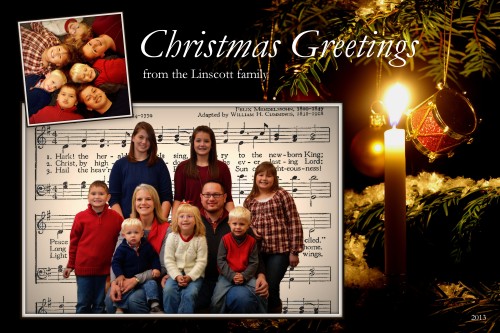 As Christians, Christmas is the time we celebrate the Advent of our Savior, Jesus Christ. With the words of Wesley’s hymn, we hope that you too can rejoice in the salvation He provided for us:
As Christians, Christmas is the time we celebrate the Advent of our Savior, Jesus Christ. With the words of Wesley’s hymn, we hope that you too can rejoice in the salvation He provided for us:
Mild He lays His glory by,
Born that man no more may die.
Born to raise the sons of earth,
Born to give them second birth.
2013 is winding dow n its last days, and we in the Linscott family are thankful for God’s provision to us over the past year. This February will mark the completion of our 6th year here in Marshall, and we have truly grown to love the place God has planted us in. By the time you read this, Greg should have finished the classwork for a Master’s degree from Baptist Bible Seminary in Clarks Sumnmit, PA.
n its last days, and we in the Linscott family are thankful for God’s provision to us over the past year. This February will mark the completion of our 6th year here in Marshall, and we have truly grown to love the place God has planted us in. By the time you read this, Greg should have finished the classwork for a Master’s degree from Baptist Bible Seminary in Clarks Sumnmit, PA.
Jennifer recently completed a dieting process of over 2 years, losing 115 lbs. in the course of that time. The children are developing and maturing. Abby, Kati, and Dori continue their responsibilities delivering papers for the Marshall Independent. Caleb and Emma started wearing glasses. Abby continues her love of drawing, and started Driver’s Education. Kati continues to play her violin with the Southwest Minnesota Orchestra. She and Dori are taking piano lessons, and were joined this year by Reggie taking violin lessons, too. Abby and Kati are accompanying the congregation in hymn singing- Abby on her guitar and clarinet, and Kati on her violin.
 January was an interesting month for our family. Reggie and Emma played basketball with the Marshall Community Services programs for their age groups. Jennifer spent a week with her parents in Grand Rapids, following her father’s hip replacement surgery. Dad and the kids survived her absence without any significant problems, though Dad did end up conducting a funeral at the church while she was gone. He also managed to arrange for the family dog to spend a weekend away… something we’ll come back to later…
January was an interesting month for our family. Reggie and Emma played basketball with the Marshall Community Services programs for their age groups. Jennifer spent a week with her parents in Grand Rapids, following her father’s hip replacement surgery. Dad and the kids survived her absence without any significant problems, though Dad did end up conducting a funeral at the church while she was gone. He also managed to arrange for the family dog to spend a weekend away… something we’ll come back to later…
 Just about every day in February had at least one member of the Linscott family down with the flu- the odds of such things increase with 9 family members! With that being said, we still managed to navigate through a month of normal activities, including the annual Grand Prix race at church, and a band concert for the girls. Greg and Jennifer celebrated 18 years of marriage, and Reggie celebrated his 6th birthday.
Just about every day in February had at least one member of the Linscott family down with the flu- the odds of such things increase with 9 family members! With that being said, we still managed to navigate through a month of normal activities, including the annual Grand Prix race at church, and a band concert for the girls. Greg and Jennifer celebrated 18 years of marriage, and Reggie celebrated his 6th birthday.
The most notable event for our family in March was Dori’s decision to follow Jesus in the waters of baptism. She joined 5 other baptism candidates, as well as three others who joined the church on Easter Sunday.
 The children were also involved in a production of The Pinocchio Show with other students from the Marshall Area Christian Home Educators Association. In other news, our family dog gave birth to a litter of nine golden retriever puppies, 7 of whom survived and went on to good homes.
The children were also involved in a production of The Pinocchio Show with other students from the Marshall Area Christian Home Educators Association. In other news, our family dog gave birth to a litter of nine golden retriever puppies, 7 of whom survived and went on to good homes.
 April saw plenty of snow throughout the month- enough to warrant canceling church services once or twice, even. Dori and Emma celebrated their 10th and 5th birthdays, respectively. Kati had the opportunity to accompany a men’s choir from Southwest Minnesota State University on her violin, an opportunity we were very grateful for, considering she was only in eighth grade.
April saw plenty of snow throughout the month- enough to warrant canceling church services once or twice, even. Dori and Emma celebrated their 10th and 5th birthdays, respectively. Kati had the opportunity to accompany a men’s choir from Southwest Minnesota State University on her violin, an opportunity we were very grateful for, considering she was only in eighth grade.

 In May, the adoption of our son Hayden was finalized, the youngest of the three children we have added into our family. We celebrated with an impromptu trip visiting Mount Rushmore and the Badlands of South Dakota over Memorial Day. The girls resumed their summer horse-riding lesson with Joanne Stoneberg from our church in June. Jennifer and the children were excited to complete another year of school.
In May, the adoption of our son Hayden was finalized, the youngest of the three children we have added into our family. We celebrated with an impromptu trip visiting Mount Rushmore and the Badlands of South Dakota over Memorial Day. The girls resumed their summer horse-riding lesson with Joanne Stoneberg from our church in June. Jennifer and the children were excited to complete another year of school. 
 We sent the three oldest girls to Camp Shiloh for camp in July, along with several campers from Marshall. Jennifer took the children and some of the girl’s friends to the Mall of America for an adventure-filled day. A highlight of the year included a trip to Michigan for Jennifer’s 20th high school reunion, which included a few extra days visiting with family and a detour to the Creation Museum. August saw us back in Marshall, taking in tomatoes from the garden, and gearing up for another year of home education.
We sent the three oldest girls to Camp Shiloh for camp in July, along with several campers from Marshall. Jennifer took the children and some of the girl’s friends to the Mall of America for an adventure-filled day. A highlight of the year included a trip to Michigan for Jennifer’s 20th high school reunion, which included a few extra days visiting with family and a detour to the Creation Museum. August saw us back in Marshall, taking in tomatoes from the garden, and gearing up for another year of home education.

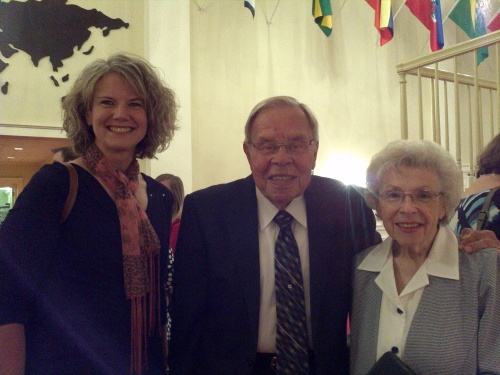
Jennifer got to see Charlie and Betty Vander Meer (Uncle Charlie of Children’s Bible Hour) while visiting her home church in Grand Rapids
 Greg oversaw the Minnesota Baptist Association’s Men’s Retreat in September. There was a very good turnout for the event, which featured Phil Johnson as speaker. Reggie joined Kati and Dori taking violin lessons. Jennifer and the kids began another year of school, and Greg celebrated his 42nd birthday.
Greg oversaw the Minnesota Baptist Association’s Men’s Retreat in September. There was a very good turnout for the event, which featured Phil Johnson as speaker. Reggie joined Kati and Dori taking violin lessons. Jennifer and the kids began another year of school, and Greg celebrated his 42nd birthday. 

October saw Abby’s 15th birthday, Kati’s first concert of the season with the Southwest Minnesota Orchestra, and our first snow of the season. Dori played volleyball with the team from Marshall Area Christian School. We also enjoyed watching the Boston Red Sox march on to their third World Series title in 10 years (well, at least watching Dad watch the games and shaking the whole house when they did something exciting….).
 Kati turned 14, Caleb turned 4, and Jennifer… had a birthday in November, too! We had a wonderful month of family celebrations. We enjoyed a Thanksgiving celebration with several people from our church, including several Karen refugees from Burma- in all, there were 60 of us who enjoyed the meal and celebration together. Greg got an 8 point buck deer hunting with the men from church, to help put some food in our freezer for the winter.
Kati turned 14, Caleb turned 4, and Jennifer… had a birthday in November, too! We had a wonderful month of family celebrations. We enjoyed a Thanksgiving celebration with several people from our church, including several Karen refugees from Burma- in all, there were 60 of us who enjoyed the meal and celebration together. Greg got an 8 point buck deer hunting with the men from church, to help put some food in our freezer for the winter.
We’re looking forward to an eventful December. We will celebrate our 2nd Christmas together as a family, as well as Hayden’s second birthday. On the church front, we plan to celebrate our 6th annual Christmas Eve Lessons and Carols service.
We wish you all a joyous Christmas season, and a prosperous 2014 as you are faithful to the commands of Christ.
Love from Greg, Jennifer, Abby, Kati, Dori, Reggie, Emma, Caleb, and Hayden
30 November 2013
Working with the Karen- An Interlude
UPDATE (12/1)- A congregational song from this morning’s service:
This isn’t a full-blown entry, but is related to the last article.
There was a nice article published in a local free newspaper about our Karen friends here.
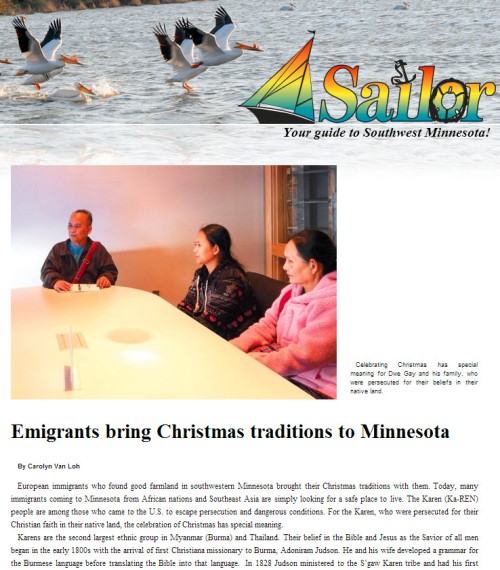
We had a wonderful Thanksgiving celebration with many of our Karen families (and a couple “native” families)- 60 people total. You can see some pictures here.
14 November 2013
Sorry For The Delay…
I have not forgotten about blogging. Things have been a little busy, lately… I’m finishing up an online course through Baptist Bible Seminary, participated in a couple of installation services for pastor friends in nearby congregations, and spending some time out deer hunting with the men of our church. I am hopeful that blogging will resume shortly, though!

